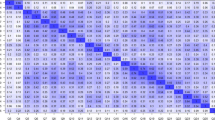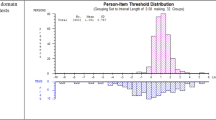Abstract
The purpose of this study was to examine the performance of the Thai-version of WHOQOL-BREF in assessing the quality of life (QoL) among Thai college students. The psychometric properties of WHOQOL-BREF were assessed in this study. The self-administered WHOQOL-BREF questionnaire was applied. A total of 407 Thai college students (male age = 20.5 ± 1.2; female age = 20.5 ± 1.2) participated in this study. Item-response distributions, internal consistency reliability, discriminant validity, criterion-related validity and construct validity through confirmatory analysis were analyzed. The findings indicate that the WHOQOL-BREF had acceptable internal consistency (α = 0.73–0.83 across four domains), all items highly correlated with corresponding domain scores (r = 0.53–0.80), the indices of a two-order confirmatory factor analysis (CFA) demonstrate that the data fit the model well with allowing covary of error variances of some items, all items had good property of criterion-related validity and item discrimination and, all three domain scores except the social relationship domain had significant associations with overall QoL or general health. The results suggest that the WHOQOL-BREF was reliable and valid to health professionals in the assessment of the QoL of college-based Thai youth, but some unsuitable items may be deleted in future studies.

Similar content being viewed by others
Abbreviations
- WHOQOL:
-
World Health Organization Quality of Life
- BREF:
-
Abbreviated version
- QoL:
-
Quality of life
References
Bollen, K. A. (1989). Structural equations with latent variables. New York: Wiley.
Bonomi, A. E., Patrick, D. L., Bushnell, D. M., & Martin, M. (2000). Validation of the United States’ version of the World Health Organization Quality of Life (WHOQOL) instrument. Journal of Clinical Epidemiology, 53(1), 1–12.
Chen, K., Wu, Ch., & Yao, G. (2006). Applicability of the WHOQOL-BREF on early adolescence. Social Indicators Research, 79, 215–234.
DeVellis, R. F. (2003). Scale development: Theory and applications (2nd ed.). Thousand Oaks, CA: Sage Publications.
Findley, W. G. (1956). A rationale for evaluation of item discrimination statistics. Educational and Psychological Measurement, 16(2), 175–180.
Hwang, J., & Wang, J. (2004). Integrating health profile with survival for quality of life assessment. Quality of Life Research, 13(1), 1–10.
Kuyken, W., Orley, J., Hudelson, P., & Sartorius, N. (1994). Quality of life assessment across cultures. International Journal of Mental Health, 23(2), 5–27.
Lisiane, M., Girardi Paskulin, L. M. G., & Molzahn, A. (2007). Quality of life of older adults in Canada and Brazil. Western Journal of Nursing Research, 29(1), 10–26.
Mels, G. (2006). LISREL ® for windows: Getting started guide. Lincolnwood, IL: Scientific Software International, Inc.
Phungrassami, T. (2004). Quality of life assessment in radiotherapy patients by WHOQOL-BREF-THAI: A feasibility study. Journal of the Medical Association of Thailand, 87(12), 1459–1465.
Power, M., Bullinger, M., & Harper, A. (1999). The World Health Organization WHOQOL-100: Tests of the universality of quality of life in 15 different cultural groups worldwide. Health Psychology, 18(5), 495–505.
Rukwong, P., Chirawatkul, S., & Markovic, M. (2007). The quality of life perceptions among middle-aged women living with a disability in Isaan, Thailand. Journal of Nursing Research, 15(4), 285–295.
Sakthong, P. (2007). Psychometric properties of WHOQOL-BREF-THAI in patients with HIV/AIDS. Journal of the Medical Association of Thailand, 90(11), 2449–2460.
Skevington, S. M. (2001). Added validation of the WHOQOL-100: Pain management improves quality of life for chronic pain patients. Clinical Journal of Pain, 17(3), 264–275.
Skevington, S. M., Lotfy, M., & O’Connell, K. A. (2004a). The World Health Organization’s WHOQOL-BREF quality of life assessment: Psychometric properties and results of the international field trial A report from the WHOQOL group. Quality of Life Research, 13, 299–310.
Skevington, S. M., Sartorius, N., Amir, M., & WHOQOL Group. (2004b). Developing methods for assessing quality of life in different cultural settings: The history of the WHOQOL instruments. Social Psychiatry and Psychiatric Epidemiology, 39, 1–8.
SPSS Inc. (2006). SPSS ® base 15.0 user’s guide. Chicago, IL: SPSS Inc.
Taboonpong, S., Suttharangsee, W., & Chailangka, P. (2001). Evaluating psychometric properties of WHO quality of life questionnaire in Thai elderly. Journal of Gerontology and Geriatric Medicine, 2, 6–12.
Trompenaars, F. J., Masthoff, E. D., Van Heck, G. L., Hodiamont, P. P., & De Vries, J. (2005). Content validity, construct validity, and reliability of the WHOQOL-BREF in a population of Dutch adult psychiatric outpatients. Quality of Life Research, 14, 151–160.
Wang, B., Hertog, S., Meier, S., Lou, C., & Gao, E. (2005). The potential of comprehensive sex education in China: Findings from suburban Shanghai. International Family Planning Perspectives, 31(2), 63–72.
WHOQOL Group. (1994). Development of the WHOQOL: Rationale and current status. International Journal of Mental Health, 23(3), 24–56.
WHOQOL Group. (1998). Development of the World Health Organization WHOQOL-BREF quality of life assessment. Psychological Medicine, 28(3), 551–558.
World Health Organization. (1996). WHOQOL-BREF introduction, administration, scoring and generic version of the assessment. Geneva: WHO.
World Health Organization. (1998). The World Health Organization. WHOQOL user manual. Geneva: WHO.
Yoo, K., Lee, S. H., Kwon, B. E., Chung, S., & Kim, S. (2005). HIV/AIDS knowledge, attitudes, related behaviors, and sources of information among Korean adolescents. Journal of School Health, 75(10), 393–399.
Author information
Authors and Affiliations
Corresponding author
Rights and permissions
About this article
Cite this article
Li, K., Kay, N.S. & Nokkaew, N. The Performance of the World Health Organization’s WHOQOL-BREF in Assessing the Quality of Life of Thai College Students. Soc Indic Res 90, 489–501 (2009). https://doi.org/10.1007/s11205-008-9272-1
Received:
Accepted:
Published:
Issue Date:
DOI: https://doi.org/10.1007/s11205-008-9272-1




